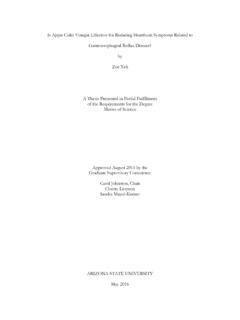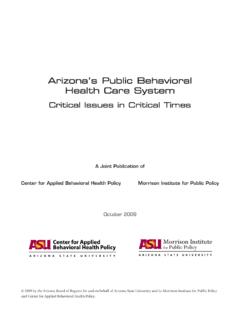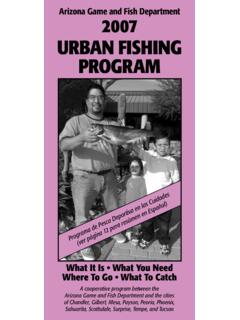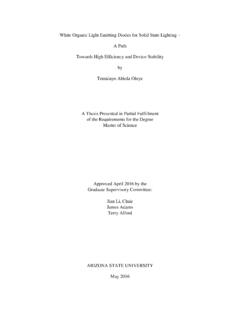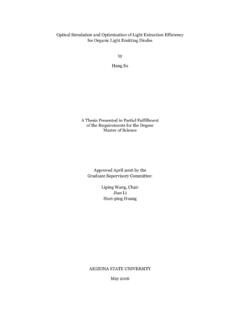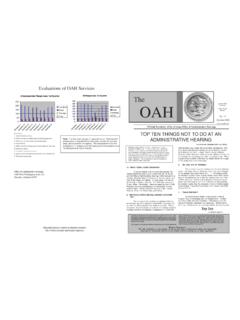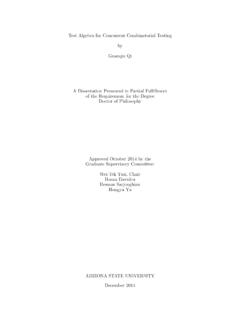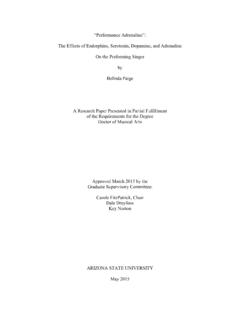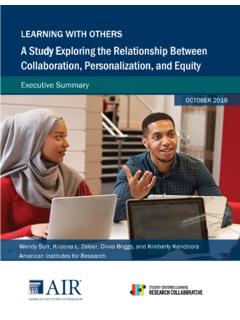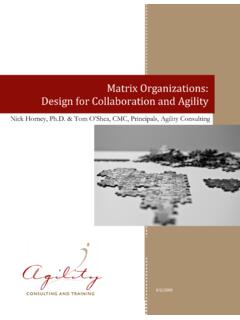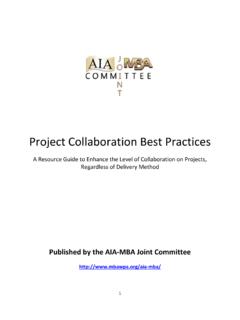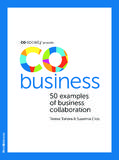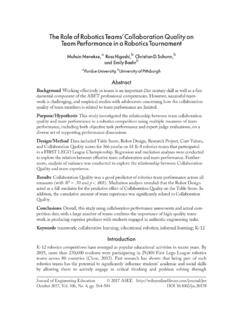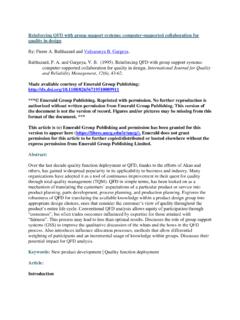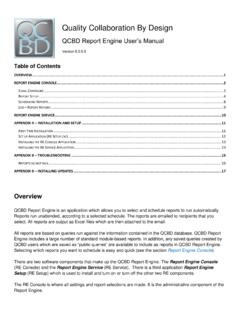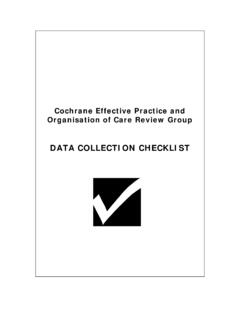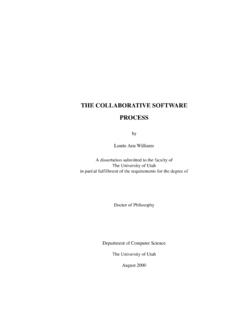Transcription of Communication, Goals and Collaboration in Buyer-Supplier ...
1 communication , Goals and Collaboration in Buyer-Supplier Joint Product design by Tingting Yan A Dissertation Presented in Partial Fulfillment of the Requirements for the Degree Doctor of Philosophy Approved April 2011 by the Graduate Supervisory Committee : Kevin Dooley, Chair Thomas Choi Joseph Carter ARIZONA STATE UNIVERSITY May 2011 i ABSTRACT Original equipment manufacturers (buyers) are increasingly involving suppliers in new product development as a means to increase efficiency and expand capabilities. To realize such benefits, however, the two firms need to have appropriate communication and goal structures to minimize friction while maximizing design quality .
2 In addition, the effectiveness of the inter-firm interaction process, their Collaboration quality , is also a key success factor. This study draws from Information Process Theory to propose that higher technical and relational uncertainty requires more inter-firm communication . The misalignment between communication intensity and uncertainty reduces both design quality and design efficiency. Goal incongruence, which always lowers project performance, is less harmful for projects with high technical uncertainty due to the potential of the conflict resolving process in improving decision quality and efficiency.
3 Finally I use Hackman s theory of work group effectiveness to propose that Collaboration quality fully mediates the effects of communication intensity and goal congruence on project outcomes. The study used an empirical survey of manufacturers as the primary method of data collection. Manufacturers that integrate and assemble complex and discrete products are the target population. design engineers and project managers from manufacturers were my target respondents. Both SEM and hierarchical regression were used to test the conceptual model. The dissertation made five theoretical contributions.
4 First, I introduced the concept that there is an optimal level of inter-firm communication intensity, exceeding which lowers design efficiency without improving design quality . Second, I theoretically defined and empirically operationalized two types of uncertainty, one on the project level and one on the inter-firm level, which were shown to moderate the effects of inter-firm communication and ii goal structures on Collaboration outcomes. Third, this study examined the conditions when goal congruence is more effective in improving Collaboration outcomes.
5 Fourth, this study nominally and operationally defined Collaboration quality , a theoretical construct which measure the effectiveness of inter-partner interactions rather than mere existence or amount of certain activities pursued by partners. Finally, I proposed several enhancements to existing construct measures. iii ACKNOWLEDGEMENTS It is a pleasure to thank those who make this dissertation possible. Throughout the past few years a great many have extended their help through advice, guidance and personal forfeitures. I will be forever indebted to each of them.
6 I would like to express my deepest gratitude to my advisor, Professor Kevin Dooley, for his guidance, caring, encouragement, and patience. No matter when I talk with Dr. Dooley, the discussion always produces new insights and motivates me to move forward. I am also grateful to the fact that he helped me go through the toughest period when I thought I could never finish the dissertation. I am grateful for the advice and encouragement of other committee members, Professor Thomas Choi and Professor Joseph Carter. They helped significantly improve the theoretical strength and empirical rigor of this work.
7 Other faculty members have been instrumental throughout my doctoral studies, particularly Professor Elliot Rabinovich, Philip Carter, Vicki Smith-Daniels, William Verdini , Hongmin Li , Adegoke Oke, Michele Pfund and Thomas Kull. It is always my pleasure to talk with fellow PhD students, who have helped sharpen my skills and enrich my knowledge. Most importantly, they make me feel that I am not alone in this tough venturing process. Specifically, I would like to thank Mei Li, Yusoon Kim, John Ni, Nan Liu, Sung Kang, Keith Tran, Adrian Tan and Yunsook Hong.
8 Special thanks should also be given to colleagues outside ASU, who coach me to be a true scholar through working with me on research projects. I would like to thank Professor Philip Evers from University of Maryland, Professor John Anderson from University of Minnesota and Professor Arash I Azadegan from New Mexico State University. I would also like to thank the Institute of Supply Management and ASU Graduate and Professional Student Association for their financial assistance. iv I would never be able to finish this dissertation without the support of my family.
9 To my husband, Shaojun, thank you for being such a supportive partner with endless love and tolerance in the past five years. To my sister, Huibin, thank you for intellectually guiding me and emotionally supporting me. To my Mom and Dad, thank you for always believing in me and being proud of me. To my daughter, Fiona, thank you for bringing so much joy and meaning to my life. Lastly but most importantly, I would like to thank God for his grace, which allowed me to understand the meaning of life and experience the truth in the past few years. v TABLE OF CONTENTS Page LIST OF TABLES.
10 Viii LIST OF FIGURES .. x CHAPTER 1 OVERVIEW OF THE RESEARCH .. 1 Introduction .. 1 Research questions .. 3 Research context and Unit of Analysis .. 7 Methods and analysis summary .. 7 Theoretical and practical contributions .. 8 Overview of the study .. 9 2 LITERATURE REVIEW .. 10 communication structure and performance .. 10 Goal congruence and performance .. 14 Collaboration quality and performance .. 17 The interactions among communication structure, goal congruence and Collaboration quality .. 22 Chapter summary: gaps in the literature and my contributions.
